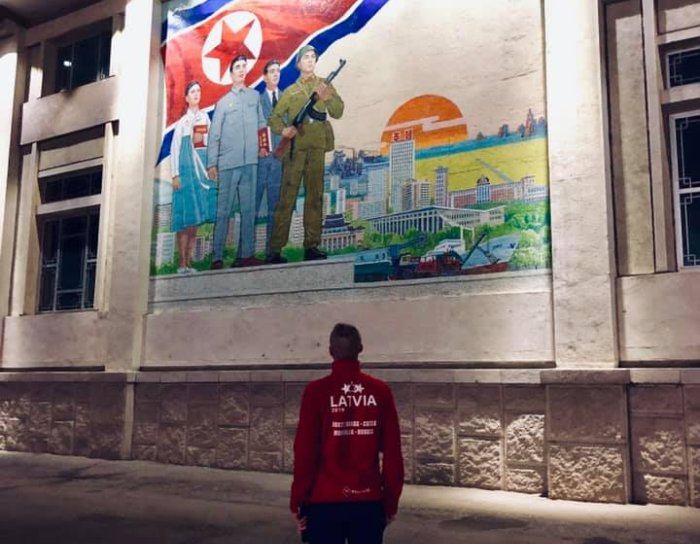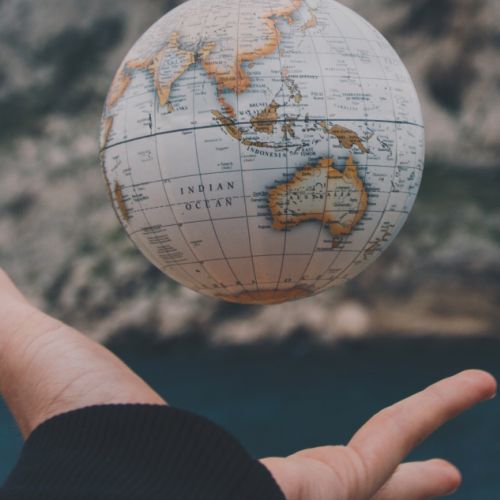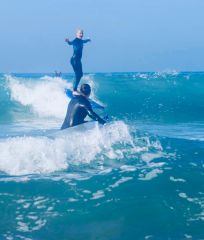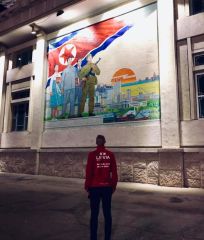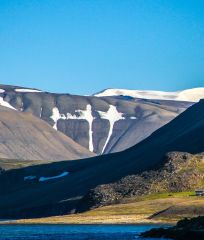The formal reason for the trip was participation in the famous Pyongyang Marathon. But of course, the real reason was to see how things actually are there.
I enjoy seeing places with my own eyes where people live differently. It provides an opportunity to compare, appreciate, and also look at oneself from a different perspective. None of us is knowledgeable enough to judge how to live "correctly" and how not to.
There were ten people in our group, each with varying travel experiences. There were no complainers who demanded a hotel, a shower, and white sheets every night. However, when the train slowly crossed the bridge, our loud group voices subsided. We anxiously and curiously looked out through the train window, capturing our first impressions. All bravado remained on the Chinese side. None of us knew how to behave, what is allowed and what is not. We have been instructed multiple times about what is allowed in North Korea and what is not, yet internally we are probably all ready to hear a loud command in an incomprehensible language or a gesture with a rifle butt.
Outside the train window, the first border posts and soldiers appear. After a moment, the first border crossing station. Many people dressed in uniforms board the train. Document checks, customs. Morally, we are prepared to be lined up immediately, to walk where we are told, to have our bags emptied on the floor and every detail checked. We have even been instructed not to have "inappropriate" and ideologically inconsistent information, photos, or anything else on our phones that would cast a shadow on North Korea's system.
The first shock - nothing like that. Document checks are the same as at other borders, very correct and professional. Customs check - I would even say superficial. They ask to write down the brand of a mobile phone from a certain company (we notice that owners of Huawei phones show positive emotions), ask how many cameras and video cameras each person has. Even my declared three cameras (Sony and two GoPros) do not elicit any emotions. If there are - then it's necessary. There is minimal interest in our bags; we could easily bring a drone, which is currently left at the Chinese hotel, as well as a pile of weapons and grenades! After the check, they ask us to get off the train and take us to a separate waiting room. We are observed by a uniformed lady, but after a while, we can buy North Korean beer.
After about an hour, we are allowed to board the train again and continue the journey to Pyongyang, where we arrive late in the evening, as dusk begins. On the way, we eagerly capture our first impressions, filming and photographing through the train windows. We pass by gray, monotonous rural landscapes, sometimes adorned with red posters, flags, and portraits of leaders. Overall, the view is quite poor; the scarce agricultural machinery recalls post-war collective farms in the USSR.
At the Pyongyang station, we are greeted by two guides - the friendly Una (her real name was longer and more "Korean," but we immediately agreed to shorten it) and her slightly older colleague. We are instructed to stay together at all times; movement without guides is not allowed. We board a bus and head to the hotel. The hotel turns out to be of a relatively high standard, everything in marble, looks like a solid four stars. There are several souvenir shops selling quite normal local souvenirs (although the prices are similar to those in Europe).
We go to dinner. "Buffet style," the dishes are somewhat specific, but overall of good quality, excellent service. I am surprised by the fluffy "buns" that are translated as "steamed bread."
The next morning, it's our "Big Day"! The Pyongyang Marathon!
From early morning, we board the bus and head to the central stadium. Thousands of foreigners are gathered around. Our team stands out in their red outfits among the rest. David organizes a warm-up training right in front of the stadium, which catches the attention of journalists, especially the Singaporean TV - we are filmed and interviewed. We enter the stadium, listen to a speech by a minister. There are tens of thousands of spectators in the stands who cheer us on. A drone flies in the air, capturing it all - oh! Why not mine as well?
After the ceremonial speech, we gather in our running groups (I signed up for the 10 km) - and off we go! The marathon will take place on the main streets of Pyongyang, with a designated route. Along the sides, there are many spectators, and every 50 meters or so, there are water stations. However, again, no rifles! People along the sidelines smile, wave their hands, and cheer us on. Obviously, I'm not aiming for a record; I'm not among the leaders or the losers - I'm somewhere in the middle. It's like the Olympics - the main thing is not to win but to participate! Moreover, it seems that the local runners in the lead have prepared well.
I complete my ten kilometers and finish in the stadium. The stands erupt in cheers! Overall, the organization is normal (although it could have been better for theThe formal reason for the trip is participation in the famous Pyongyang Marathon. But, of course, the real reason is to see how things really are there.
After the award ceremony, they take us to a fairly normal restaurant for lunch, and then to a water park. The water park is about the size of our local "Līvu Water Park," maybe slightly smaller. The entrance fee is 10 euros (definitely different for locals). For this price, everyone receives a basket with a towel, swim trunks/swimsuit (women's swimsuits make us burst into laughter), a swimming cap, and shampoo. Just like with people, the water park is full of children. It's hard to believe that it's only for some privileged few.
Oh, and about the city—wide streets, a new city, lots of modern buildings in the center. Most of them, judging by the architecture, are residential, but there are also several public buildings. The asphalt and road conditions are nothing special. It could be better, but it's not like that everywhere in Riga either. There are very few cars, and the streets seem empty. Public transportation is old, reminiscent of our 80s. Old trolleybuses, old Czech trams, which used to be in Riga as well. Passing by, we see overcrowded public transport and queues at the stops. There are very few private cars, mostly Russian, Chinese, and Japanese cars dominate. We find out that most of them are state-owned cars (you can determine their ownership by the license plate color). The fanciest car with a "private" license plate is a new Mercedes B-Class. When we ask who drives it and how much it costs, the guide hesitates. In the evening, it surprises us that very few windows have lights on, the city is quite dark. The guide explains that many people are still at work, but it doesn't sound very convincing.
The evening ends in a restaurant where we are entertained by a girls' ensemble. The music is provided by four girls with a violin, a bass guitar, keyboards, and drums, and four other girls sing something that could be called local pop music. Either they change outfits for each song, or they have several "sets"—it is difficult to capture. But they actively try to involve us in their performance as well. Meanwhile, the local television shows a report on today's marathon, and we receive commemorative medals.
Returning to the hotel, we have a small party. The guides stay at the same hotel as us (probably so they don't lose sight of us). They actively participate in the party. The guide chooses a Tequila Sunrise (not a bad choice in North Korea!), while the male guide is delighted with the electronic cigarettes. He borrows them several times to go and "show off" to the other guides. Now we understand that if someone wants to smuggle something here, they should bring electronic cigarettes—guaranteed success! Even the packs of "Camel" cigarettes that I brought are gratefully accepted. Smoking here is considered stylish and exclusive...
We want to experience the real taste of North Korea, so we plan to visit the famous "Kim" monument tomorrow. Surprisingly, the guides react cautiously. It seems that it is not part of the program, and they are afraid that we won't behave "properly" there. We assure them that everything will be fine. The guides stay with us until late at night and express skepticism about starting the next day at 7:00 with a tour to the monument. After a few glasses of wine, Una "reveals" more provocative questions, including the possibility of leaving North Korea. It turns out that going to "friendly countries" (China, Russia) is quite realistic for them. Una also casually explains the opportunities for a North Korean woman to marry a foreigner. The potential groom has to go to the North Korean embassy and submit an application, and then permission to leave will be granted. Furthermore, several times she casually talks about how she envisions her future family life (she is unmarried), being a good wife, taking care of the house, and raising two children.
When we all gather in the hotel lobby the next morning at 7:00, the guides are genuinely surprised. However, it is true that they don't look their best!
We head to the monument of both Kims. We are instructed again that it is a sacred place and we must behave respectfully, quietly, and with dignity. We buy an expensive bouquet of flowers for 15 euros and approach the gigantic bronze statues.
Now let's take a brief look at North Korean history. Before World War II, the Korean Peninsula was occupied by Japan. Kim Il-sung led the resistance against Japanese occupation, starting as a simple soldier and ending as a general. After World War II, the Korean Peninsula was divided similarly to Germany—North Korea remained under Soviet control, while South Korea was under Allied control. When the Korean War broke out, Kim Il-sung led the fight for reunification, and North Korea had to fight against South Korea, supported by the United States and England. Apart from some limited support from the Soviet Union and China, North Korea had no allies and had to rely solely on its own strength. Hence, the ideology of the ruling party, "Juche," which means "self-reliance." Unlike Latvia, where totalitarianism was "imported" from outside, I would compare North Korea's first leader more to our Uļmanis than to Stalin. Only he personally participated in the resistance movement, unlike ours...
Knowing these facts, it would not be right to call Kim Il-sung a dictator and criticize him for his personality cult. It seems that North Koreans truly love and respect him as their national hero. That's why we were repeatedly emphasized that this is a sacred place. As for the widely spread myth that there is a personality cult and dictatorship in North Korea, we didn't see any images of the current leader Kim Jong-un anywhere. I still vividly remember my childhood in Riga when there were Brezhnev portraits decorating every street. In North Korea, you will only see figures or images of the two deceased leaders. And if in the Soviet Union it was possible to buy Lenin and subsequent leaders' portraits and symbols on every corner, there are no such items for sale here. I secretly hoped to bring something like that home as a souvenir, but there is none! Yes, we see a few locals wearing badges with the images of the first two leaders on their chests, but souvenir shops don't sell them; there are only small badges with the North Korean flag.
The atmosphere around the statues is solemn. Soft music plays in the background, and small groups of people gather at the monument from time to time. The monument is located on a hill, continuously bathed in sunlight. On both sides of the "Two Kims" statues, there are groups of stone sculptures symbolizing the struggle against the occupiers. The whole group stands as instructed, in a line, while Valdis goes to the monument to lay the flowers. The composition is only slightly disturbed by the selfie stick I'm holding with an Insta360 camera!
After placing the flowers, we can take photos near the monument. We have also received "instructions" on how to photograph the monument—everything must be visible in the frame, no parts should be cut off. Speaking of photography, contrary to the common myth, there are no significant restrictions. It is only forbidden to photograph military personnel (but that's the case in many countries) and unfinished construction sites. For example, at one point, I am warned not to photograph the Ministry
After visiting the monument, our journey continues to the main library. It is located in a huge building that also serves as an educational institution with many classrooms where students acquire knowledge. It is popular to gain knowledge alongside work to improve skills. IT specialties and languages are in demand. The librarian proudly announces that the library has books in almost all languages of the world. Well, let's check it out—please bring us something in Latvian! However, this task proves to be difficult. In two attempts, we only manage to find books in Lithuanian. But in the audiobook section, we are allowed to listen to a cassette with "Pūt, vējiņi!" and "Es karā aiziedams."
After the library, we take a walk through the city along the coast. Later, we visit the Monument to the Founding of the Party and climb a tall tower that provides a view of the entire city. The city looks well-maintained and even beautiful, but... from the viewpoint, we can see that the modern construction ends a bit further from the center, and less impressive buildings take its place. We then take a bus to reach the monument. Here, for the first time, we witness exotic sights—around 150 women in red jackets, accompanied by patriotic music, waving red flags, preparing for a big public show. It is staged... I don't even know how to describe it, maybe it's a dance? The guide explains that these are housewives, and this is their pastime. If I hadn't seen something similar on the other side of the border in China, I probably wouldn't believe it, but now...
Next, we have lunch at a restaurant. We conclude that the cold glass noodle soup tastes much better than it looks, especially when a Korean girl comes and demonstrates how to prepare and eat it properly. After satisfying our hunger, we set out to explore the local metro. The few stations we see are adorned with patriotic wall paintings, although the overall appearance is quite average. The subway cars and other equipment are similar to what was in Moscow in the 80s. However, it is claimed to be the deepest metro in the world (at least according to the Koreans), and it probably serves as a shelter in case of war.
After two metro stops, our bus awaits us above ground and takes us to the War Museum. Here, the security check with a metal detector is stricter, and we receive instructions that outdoor exhibits can be photographed, but photography is prohibited inside the museum. Our guide is a small Korean woman in a military uniform who speaks Russian quite well. This museum is dedicated to the Korean War of 1950-1952. The visit starts with an exhibition of trophies confiscated from the Americans—dozens of tanks, cars, and airplanes are displayed. The guide's narrative is quite patriotic, frequently using phrases like "American aggressors" and "imperialists." We are also shown many captured American surveillance technology samples, such as helicopters and spy planes, which were captured and shot down after the official end of the war. The highlight of the outdoor exhibit is the captured American spy ship "Pueblo," which was captured in North Korean waters. We can walk around the ship docked by the riverbank and see that it is equipped with electronic devices and armed with heavy-caliber machine guns. The ship's crew has returned home after long negotiations and the US apology, but the ship remains as a trophy in North Korea.
Inside the massive museum building, we are amazed by its size and high-level presentation. The exhibits are very well organized, showing soldiers in combat, captured American soldiers, and their atrocities against civilians. The guide's narrative, however, includes a lot of rhetoric, such as "When our leader decided, we strategically withdrew from Seoul" ... but she urges us to further study these pages of history from independent sources. The end of the exhibition features a huge circular hall with seated viewers, and the dome slowly rotates, showcasing artistically crafted battlefield scenes.
We are hurriedly escorted out of the museum because we have a few more events scheduled for tonight—the first of which is a visit to the circus. The program includes several high-level acrobatic performances and trained dogs. Overall, our impression is quite positive.
Our desire for exotic experiences is hard to satisfy, so we have asked the guides to take us to another attraction after the circus—we head to a shooting range. Where else can you shoot guns if not in one of the most militarized countries in the world? The shooting range surprises us with its size and high-tech equipment. Computers are everywhere, and targets are visible on video screens, meeting modern standards. I don't know of a shooting range in Latvia at this level. However, I am slightly disappointed with the selection of firearms because initially, we were promised the opportunity to try serious automatic weapons, but it turns out that only a few archaic small-caliber pistols and shotguns with various attachments are available. But the biggest shock and surprise await us in the other building of the complex... here, for 1 USD, you can shoot at targets, and for 5 USD, you can shoot live chickens that are placed at a certain distance, calmly pecking grains... that's what the computerized target system displays...
The evening concludes in a restaurant where a roasted chicken barbecue is prepared before us. Unfortunately, this is our last evening in North Korea, and the next morning, the guides accompany us to the train station.
